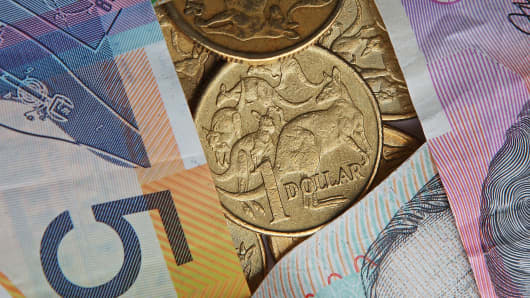What goes up must come down. This is finally holding true for the resilient Australian dollar that has begun to show weakness against the greenback given the latter's broad-based strength.
The Aussie dollar fell below the key $1 mark on Friday, its lowest level in almost a year, and stayed there in early Asian trade on Monday. It has shed about 2 percent of its value since last Thursday, taking its losses against the U.S. dollar so far this year to almost 4 percent.
Analysts say the strength in the greenback as the outlook for the U.S. economy improves and concerns about economic growth in China, Australia's most important trading partner, explain the change of fortunes for the Australian dollar – one of the world's best performing major currencies in recent years.
"The move in dollar/yen to 100 triggered a wave of buying in the U.S. dollar, so the sell-off in the Aussie is part of this," said Sean Callow, senior currency strategist at Westpac Bank in Sydney.
"If the U.S. dollar rallies some more, the Aussie dollar could suffer the most since it gained more than most currencies from weakness in the dollar," he added.
Callow said the Aussie was vulnerable to further near-term weakness and expected the currency to fall to around $0.96 by June 2014, implying a decline of about 3 percent from current levels.
But despite its pull-back this year, the Aussie dollar is up some 60 percent from where it traded in early 2009 as the world emerged from the global financial crisis.
While Australia's relatively high interest rates and resilient economy have bolstered the Aussie, signs are growing that the resilient currency is falling out of favor with investors.
(Read More: Why Shorting the Aussie Is 'Trade of the Century')
Data released on Friday from the Commodity Futures Trading Commission, showed that net long positions on the Australian dollar, essentially a bet that the currency will rise, fell to $675 million in the week to May 7 to their lowest level since June last year. That was down sharply from $3.2 billion in the previous week.
A surprise quarter point rate cut from Australia's central bank and talk in markets that billionaire investor George Soros was planning to take a short position on the currency have added to the Aussie's bumpy ride over the past week.
(Read More: Soros Rumor Underpins Turning Tide Against Aussie)
"I don't think the Aussie dollar is about to collapse, but it should move back some more from here," Greg Gibbs, senior currency strategist at Royal Bank of Scotland told CNBC Asia's "Squawk Box."
Gibbs said the Aussie dollar was also proving sensitive to Chinese economic news and that data out of the world's second largest economy could prove key to the currency's near-term direction.
"I do sense that the Aussie dollar is trading as a proxy for China and investors are questioning the strength of the Chinese recovery," Gibbs said.
China's recent economic data has been mixed. Manufacturing surveys paint a sluggish outlook for economic growth although trade data last week surprised markets with a bigger-than-expected rise in exports last month.
— By CNBC.Com's Dhara Ranasinghe; Follow her on Twitter at @DharaCNBC



